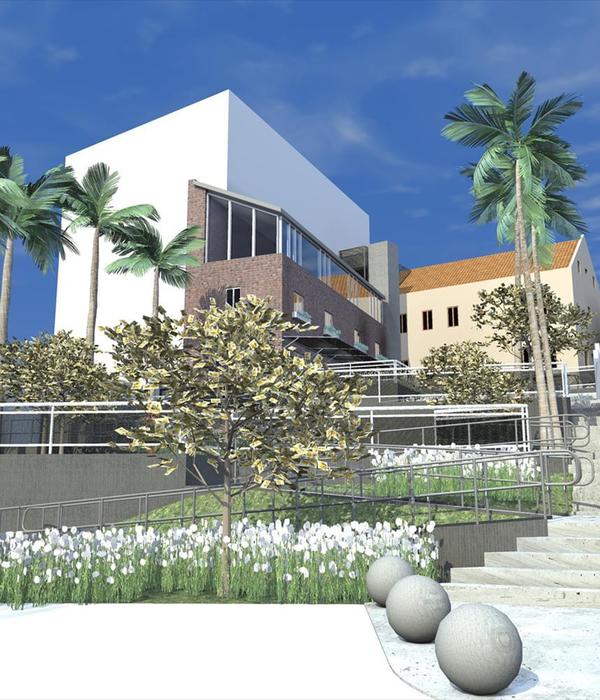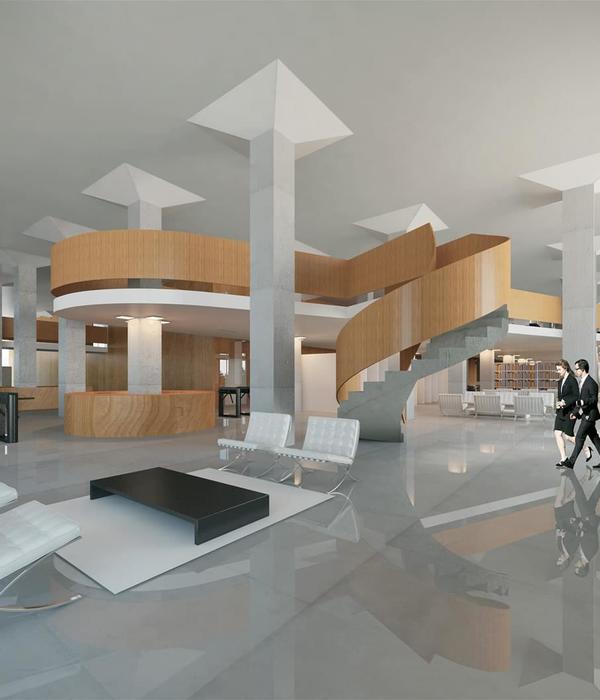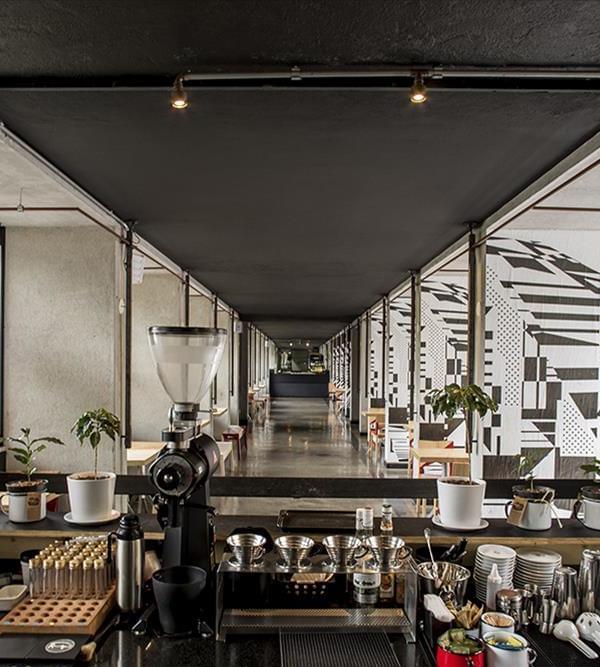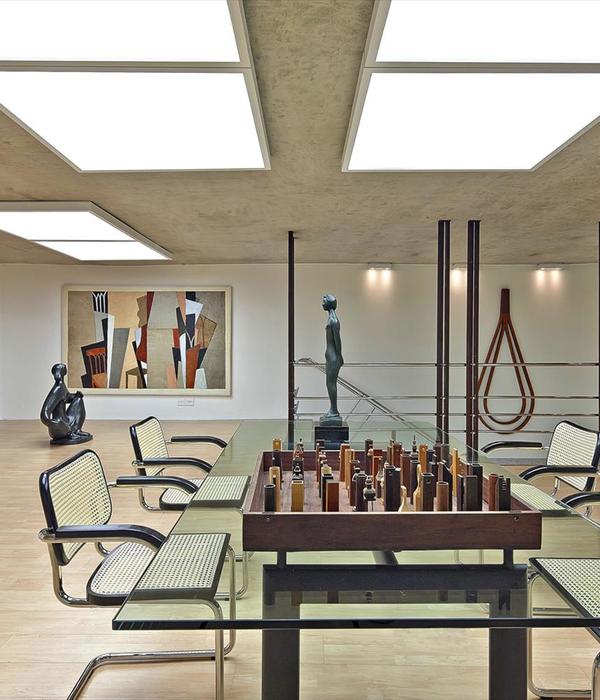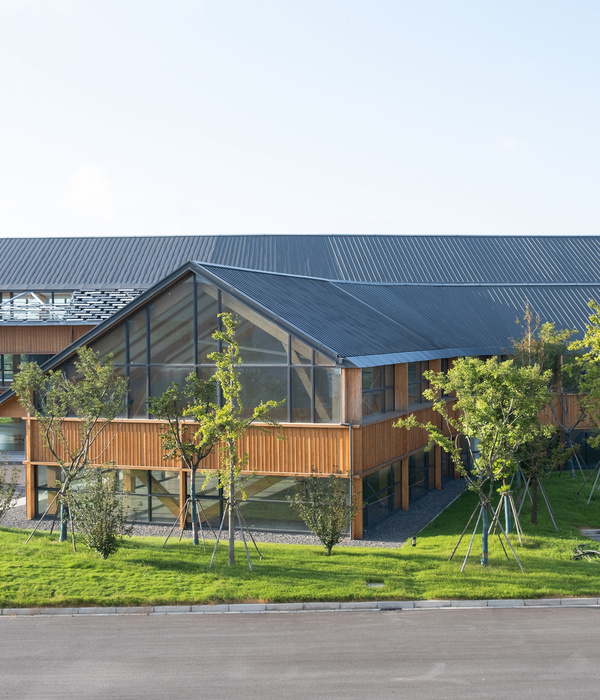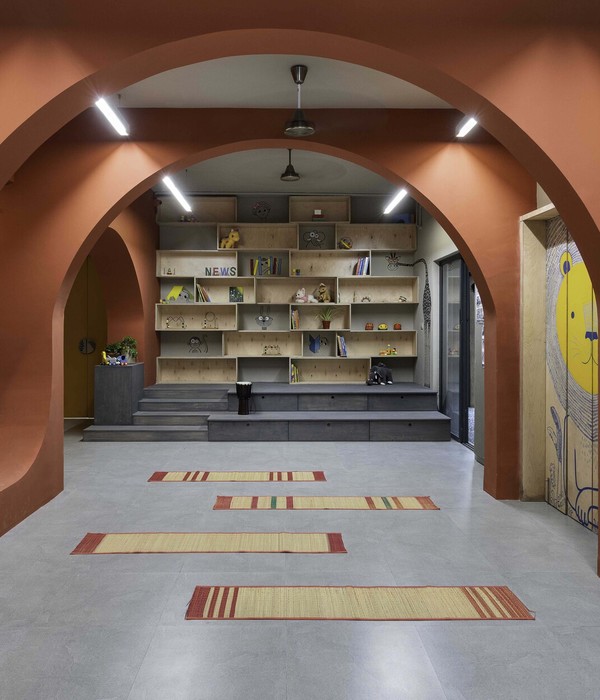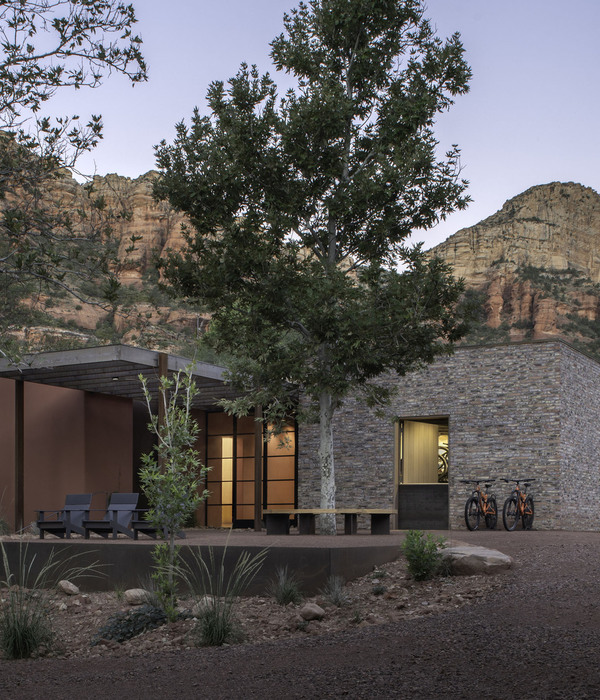2020年春,MVRDV完成了世界上最大木结构建筑的设计,该项目位于俄罗斯圣彼得堡历史悠久的奥赫塔角。这里曾经遍布湿地和茂密的树林,如今已被堡垒、园林苗圃、船坞以及各类工厂所取代。该地区已沉睡多年,MVRDV设计的俄罗斯天然气工业石油公司总部(以下简称“俄气”)能够再次唤醒它的价值。
As of spring 2020, MVRDV designed the largest timber building in the world for Saint Petersburg’s historic Okhta Cape. Once thick with trees and marshland, the site has been home to fortresses, a tree nursery, shipyards, and factories. After many years lying dormant, this design inspires its fruition as the commercial headquarters for Gazprom Neft.
图/Image: © MIR
俄气新总部位于俄罗斯圣彼得堡历史悠久的奥赫塔角,拥有丰富的景观资源
The new headquarters of Gazprom Neft is in Saint Petersburg’s historic Okhta Cape with rich embankment landscape
这座碳中和建筑高28米,由119根木柱支撑,它赞美了堤岸的景观文脉及当地丰富而又传奇的历史。充满自由气息的“森林楼层”是一个向公众免费开放的公园和广场,突出了场地的历史;而办公空间位于木柱顶部的“树冠”层。长满当地植物的屋顶景观覆盖了这座商业综合体,屋顶景观与下方的公园景观可以一同帮助海角恢复生物多样性。在这种设计中,建筑即为景观,景观即为建筑;MVRDV力求在所有设计中清晰地体现“绿色转变”的理念。
A celebration of the embankment landscape context, its rich and storied history, the carbon-neutral building stands 28 meters high, and is supported by a forest of 119 wood columns. This “forest floor” is free and open to the public with a park and plaza that highlight the history of the site, while the office space lies above in the columns’ “tree” canopy. A roof-scape with native vegetation crowns this commercial complex, helping to rehabilitate the cape’s biodiversity, as in the landscaping of the park below. This way, building is landscape and landscape is building; a clear embodiment of the ‘green shift’ MVRDV strives for in all designs.
图/Image: ©
MIR
综合体由119根木柱支撑,是一座碳中和建筑
The carbon-neutral building is supported by a forest of 119 wood columns
俄罗斯是全球温室气体排放量第三大的国家,为该国能源公司俄气的总部设计一个地标型建筑,这似乎与MVRDV激进和永不妥协的可持续设计理念背道而驰。为了坚持信念同时解决这种矛盾,MVRDV希望制定一种最可持续的建筑方案:这种建筑既能封存碳,又不消耗化石燃料。为此,MVRDV研究了场地的历史和景观,最终选用一种可持续的方法来打造一个真正高效的建筑。MVRDV的方案还体现了圣彼得堡的自然遗产,它把奥赫塔角与堤岸的自然生态系统连接起来。新的俄气总部不仅将遵循联合国可持续发展目标的原则,还将复杂的体量布局与对景观的微妙处理结合在一起,增强了圣彼得堡的城市形象和并提升其作为国际化大都市的成熟度。
Designing an iconic architectural landmark headquarters for one of the top three global emissions producers dramatically contradicts with MVRDV’s radical and uncompromised dedication to sustainable design. So as not to surrender to contradiction, MVRDV committed to creating the most sustainable building design possible: a building that sequesters carbon, and does not consume fossil fuel energy. To do this, MVRDV looked to the history and landscape of the site, selecting a sustainable approach to make a truly high-performing building. The design also reflects Saint Petersburg’s heritage, drawing the Okhta Cape into connection with the natural ecosystem of the river embankment. A delicate approach to the landscape, in combination with the complex configuration of volumes, reinforces the profile and sophistication of Saint Petersburg, while adhering to the principles of the UN’s Sustainable Development Goals.
图/Image: ©
MIR
长满当地植物的屋顶景观覆盖了这座商业综合体,可以帮助海角恢复生物多样性
A roof-scape with native vegetation crowns this commercial complex, helping to rehabilitate the cape’s biodiversity
项目主创建筑师、MVRDV的联合创始人之一Winy Maas说道:“MVRDV内部就是否应该参与这样一个全球碳排放量生产大户的项目进行了大量讨论。最终我们决定在坚持可持续设计的条件下,为俄气在圣彼得堡的新总部提供一个激进的和毫不妥协的解决方案——一座全部使用清洁能源的碳封存建筑,并为这座城市创造一个真正的新公园。”
Architect Winy Maas, co-founder of MVRDV: ‘After considerable debate as to whether MVRDV should engage with one of the top three producers of global carbon emissions, MVRDV decided to uphold our dedication to sustainable design, and pursue a radical and uncompromising design solution for Gazprom Neft’s new Saint Petersburg headquarters: a building that sequesters carbon and is powered entirely by clean energy, creating a truly new public park for the city.’
图/Image: ©
MIR
综合体内部充满自然光线和通风,空间的分布鼓励社交互动并提升了建筑的活力
Inside the complex, workspaces are awash in natural light and ventilation, with a spatial organization that supports social interaction and vibrancy
该综合体致力于为使用者创造一个智能的工作环境,其设计灵感来源于圣彼得堡传统庭院的结构。每个办公体块都与中轴线相连,这种构成方式让人联想到瓦西里·康定斯基的俄罗斯前卫主义风格。体块之间由门禁系统控制,将来如有必要,这些体块可以成为独立的建筑。综合体内部充满自然光线和通风,空间的分布鼓励社交互动并提升了建筑的活力。从远处看,体块的组合创造了一个戏剧性的异质形式,让人想起圣彼得堡巴洛克式建筑富有表现力的轮廓。
With an ambition to create an intelligent work environment, the building’s configuration takes its inspiration from the structure of traditional Saint Petersburg courtyard blocks. Individual office blocks connect to a central axis in a composition reminiscent of Wassily Kandinsky’s Russian avant-gardist style. Due to their controlled access, the blocks can therefore become independent entities, should future business needs require it. Inside the complex, workspaces are awash in natural light and ventilation, with a spatial organization that supports social interaction and vibrancy. Seen from afar, the combination of volumes creates a dramatic heterogeneous form that recalls the expressive silhouettes of Saint Petersburg’s baroque architecture.
图/Image: ©
MIR
办公空间漂浮在空中,为下方的公共广场和公园提供遮蔽
The office program floats, thus sheltering the public plaza and park below
办公空间漂浮在空中,为下方的公共广场和公园提供遮蔽。健康中心、后勤中心、博物馆和会议中心激活了公共广场,将场地与城市连接起来。奥赫塔角因此成为一种社交导管,将城市里不同的群体汇集在一起。
The office program floats, thus sheltering the public plaza and park below. A health centre, a logistics centre, a museum, and a conference centre activate this public plaza, connecting the site to the city, and ensuring that the Okhta Cape becomes a social conduit, uniting the different threads of the city under its canopy.
图/Image: © MIR
综合体的屋顶凉亭到外立面全都被太阳能电池包裹起来,建筑可因此获得充足的太阳能
It uses solar panel technology, wrapping from the roof pergola into the façade, to provide an abundance of supplemental solar power
建筑的景观屋顶增强了河流生态系统的活力。道路网络能方便游客欣赏到涅瓦河的壮丽景色,道路两旁也将充满各种各样的当地植物和动物,同时路旁的太阳能棚架可以提供充足的备用能源。节水型景观减少了灌溉需求,使得屋顶景观进一步增强了综合体的可持续性。此外,该综合体的屋顶凉亭到外立面全都被太阳能电池包裹起来,建筑可因此获得充足的太阳能。立面的智能系统实时监测太阳方位,以确保建筑获得最佳的太阳能吸收量。建筑和广场下方的洞穴状人行通道和停车拱廊向受保护的文化古迹保护区致敬,它们不仅提供安全的停车场和物流通道,同时腾出地面空间供公众使用。
The landscaped roof of the building reinforces revitalization of the river’s ecosystem. With a variety of native flora and fauna, its path system facilitates visitor access to breathtaking views of the Neva River, while the solar pergola provides abundant supplementary energy. This roof-scape enhances the complex’s highly sustainable design through xeriscape landscaping, reducing irrigation requirements. It also uses solar panel technology, wrapping from the roof pergola into the façade, to provide an abundance of supplemental solar power. This intelligent façade system tracks the sun to ensure optimal solar gain. Beneath the building, and plaza, a cavernous passageway and parkade respects protected archaeological zones, while providing secure parking and logistical access, and freeing the ground level for public use.
图/Image: © MIR
冬日的俄气新总部
The new headquarter of
Gazprom Neft
in winter
戏剧性的木结构俄气总部拥有涅瓦河堤岸令人惊叹的美景,它可以提供灵活和鼓舞人心的工作环境,为一个人口相对较少的城市提供了一片新的公共绿地。从最基本的景观开始,该建筑重建了涅瓦河的生态系统,这种“绿色转变”的策略在建筑的每一层和每一个功能和性能上重复体现。
With its breathtaking Neva embankment location, this dramatic timber headquarters is a flexible and inspiring working environment that offers a new public green space to a city with comparatively few. Beginning at the very basic level of landscape, the building renews the ecosystem of the Neva under the cape’s influence, and the strategy repeats in each level and layer of the building, and in each part of its performance and function.
MVRDV建筑规划事务所总部位于荷兰鹿特丹,致力于以国际视野在全球范围内为当代的建筑和都市问题提供解决方案。MVRDV于1993年由Winy Maas、Jacob van Rijs和Nathalie de Vries创立,事务所的创作过程基于深度研究与高度协作,各个领域的专家、客户及利益相关方从项目初期一直参与设计的全过程。直率而真诚设计成果堪称典范,让城市和景观朝向更美好的未来发展。
MVRDV以独特的工作方法设计了一系列各类型和尺度的建筑、城市规划、区域愿景、出版物、艺术装置和展览。
目前正在进行的项目包括位于荷兰鹿特丹的公共艺术仓库,法国巴黎市中心一座混合功能建筑的改造,美国纽约的一座高层混合功能建筑,以及分布在荷兰、法国、中国、印度和其他国家的各类型项目。
2018年,MVRDV被授予Architizer年度最佳公司,评审团的评语写道:
“如果世界上有一家事务所能够概括说明为何如此多的人对建筑着迷,那就是MVRDV。
”
更多详细信息,请联系MVRDV亚洲公共关系部
+86 021 6288 0609 或
{{item.text_origin}}

